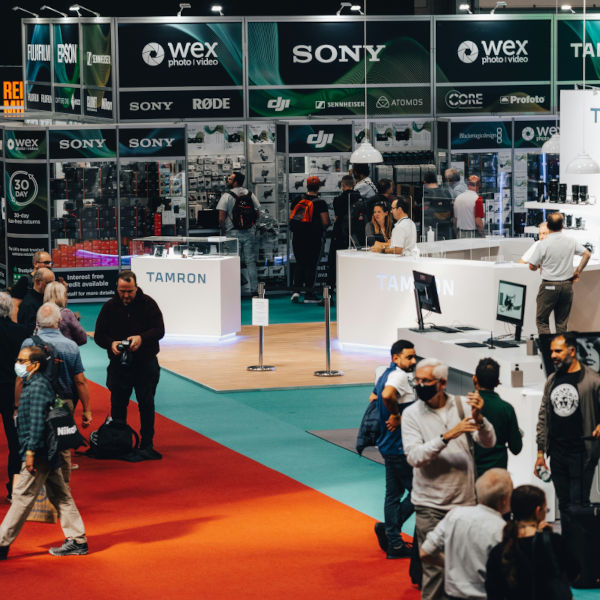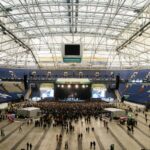Choreographing the perfect exhibition is a bit of a dance. It takes coordination and timing along with the right people, tools, and resources if you want it to be a success. And not just a success, but a spectacular event that people will be talking about for years to come.
That’s why we’ve mapped out this detailed guide on exhibition management. We have done all the compilation including hot tips and tricks to help you avoid the many pitfalls that can accompany the planning, preparation, and execution of the perfect exhibition.
We will go over the types of exhibitions, explain the CEM designation, give you a step-by-step exhibition checklist, team training recommendations, exhibition management best practices, hot tips and tricks, and more.
But let’s start with the basics first.
What Is Exhibition Management?
Exhibition management is the creation, planning, and deploying of exhibitions. This involves strategic planning, promotion, collaboration, and development in a precise, timely manner. It’s like putting a puzzle together. It has to be done piece by piece from start to finish.
Types of Exhibitions
Before you can begin planning your exhibition, you’ll need to select the type of exhibition you will need based on the intended audience.
Trade Exhibitions
Trade exhibitions, also known as commercial exhibitions, differ from consumer exhibitions. Trade exhibitions are for a B2B target audience and are created with a focus on a specific industry. Companies use these exhibitions to showcase and demonstrate their products and services.
They are also used to showcase them to other industry participants and investors. And are commonly used for networking and generating leads and sales.
Consumer Exhibitions
Consumer exhibitions, also known as expos, are for a B2C target audience. Companies use these to build brand awareness and demonstrate their products, inventions, and other goods to the general public and potential buyers.
Art Exhibitions
Art exhibitions are used to display a wide variety of art such as paintings, sculptures, interactive art, and more. They are curated to promote artists, increase brand awareness, and engage buyers.
Interpretive Exhibitions
Interpretive exhibitions are used to display historical artifacts and scientific pieces that require audience interaction and interpretation. They focus on education and increasing awareness.
Digital Exhibitions
Digital exhibitions are designed so people can view physical exhibits digitally. For example, digital museums and art galleries. These are usually interactive platforms that provide a wide variety of experiences.
What Is a CEM Designation?
CEM stands for Certified in Exhibition Management. It’s a globally recognized designation. The CEM designation reflects the highest possible professional standard in the exhibition and events management field.
Having a CEM designation shows you are a knowledgeable, dedicated professional in the exhibition and events industry.
Now, as promised, the exhibition management checklist.

Exhibition Management Checklist
Using an exhibition management checklist will provide you with a standard format you can follow and reuse for all your exhibitions going forward.
An exhibition management checklist along with an all-in-one exhibition management software, tools, and resources are the best ways to ensure you don’t inadvertently miss a step. Which is easy to do when you’re planning and executing an exhibition with many simultaneous moving parts.
1. Decide on an Event Budget
Every business venture must have a budget and it must be followed if you want it to be successful. Exhibitions are expensive. Therefore, detailed tracking of both your income and expenses is critical.
It’s also important that you take a daily accounting of your budget and share it with your shareholders and other sponsors.
So, make a budget and stick to it.
2. Select an Engaging and Memorable Theme
The theme of your exhibition is what will set the foundation for everything else you do. You need a cohesive theme and should incorporate it into every aspect of your exhibition. Your theme is what will make your exhibition exciting, engaging, and memorable. And if you can do all that, you’ve got yourself a winner.
A good way to select a winning event theme is to think about all the themed events, tradeshows, exhibitions, and parties you’ve attended over the years. Then think about which ones you enjoyed the most and why.
You can then take those aspects of your favorite event and use them to make your exhibition a success. You can also do a Google, YouTube, Instagram, Facebook, or TikTok search for inspiration. Then think outside the box and come up with something unique of your own when developing your exhibition’s branding guidelines.
3. Select an Exhibition Venue
You must select a venue with a good location. Your location needs to be convenient and centrally located. It also needs to have enough interior space, parking, ambiance, and essential amenities and services.
Get this wrong and no one will come. Get this right and it’s an exhibition no one will ever forget!
4. Design the Exhibit Floor Plan
Designing your exhibit floor plan is like building a custom house. A one-size-fits-all approach is rarely successful. Your exhibit floor plan must be tailored to meet the specific needs and objectives of your client and attendees.
Think about where and how each exhibit needs to be placed and set up. And don’t forget to design your exhibit floor plan with the attendee flow in mind.
Many exhibition and tradeshow software programs have a solution that will help you develop the best possible working flow for your exhibition.
5. Create the Event Schedule
It’s important to follow a structured schedule. Consider including the following:
- Event duration.
- Make a list of scheduled activities and include how much time each person, group, or activity will be allocated. Don’t forget to schedule some free time for networking, etc.
- Choose a time management system. Time chunking (30-minute intervals or the like) sometimes makes things more manageable.
- Visualize schedule visibility. Will you have a website, exhibition app, ads, etc.? Then visualize how you want your event schedule to look and how it will work.
- Think about the human experience. People will need regular bathroom and coffee breaks, as well as some time to decompress and mingle between activities.
6. Incorporate Interactive Experiences
You want to actively engage your attendees. That means you will need interactive elements such as demos, workshops, and other hands-on elements.
7. Begin Pre-Exhibition Promotion
Start your pre-exhibition promotions 90-180 days in advance depending on the size and extent of your exhibition. Then you can start more vigorous promotions the closer you get to your exhibition.
Think about your attendee demographics, what their interests are, where do they spend their time, and what marketing channels they are most influenced by.
Then include why your exhibition is perfect for them and their professional goals, etc.
8. Organize Exhibitor Packages
Determine what to include in your exhibitor packages. You could include exhibition positions, personalized booths, chairs, standard electrical power, access to Wi-Fi, large table space, admission tickets, etc.
Customize your exhibitor packages to meet your attendees’ specific needs.
9. Marketing & Selling Exhibition Spaces & Tickets
Based on your target audience set a competitive price. Then create a compelling exhibition pitch. Clearly outline the benefits of your exhibition. These things will help you promote your exhibition and increase your chances of success.
Then you will need to market your exhibition by posting on your social media pages to build anticipation for the event.
You could also incorporate paid media, email marketing, develop attention-grabbing landing pages, and anything else that makes sense for your specific audience.
10. Manage the Logistics of the Exhibition
How well you organize and manage the behind-the-scenes logistics of your exhibition will determine how smoothly it goes — or not. Make sure you effectively coordinate all the utilities, insurance, deliveries, installations, and anything else you have planned.
11. Measure for Event Success
If you don’t measure event success, you won’t have any way to determine what worked, what didn’t, and what could be changed or eliminated for future exhibition success.
You can measure your event goal success by counting the number of tickets sold and how many check-ins you had. Perform post-exhibition surveys, check the social media buzz about your event, and how much revenue was generated.
It’s also a good idea to do sponsor satisfaction surveys, tally your post-event sales, and follow up on any other data associated with your exhibition. Then for your future exhibitions improve on what worked and throw out what didn’t.
PRO TIP: Continually monitor and adjust your budget. Tracking your expenses is critical to your success and reputation. Shareholders and funding partners should always be kept in the loop.
12. Team Training
It’s important to take the time to train your exhibition team. Give the entire team exhibition goals and plans. Then practice role-playing, run-throughs, and demonstrations to identify potential pitfalls and overcome hurdles.
It’s also a good idea to develop a list of common questions the attendees might ask. This will help ensure the staff is well-versed in providing cohesive, coordinated answers. And this will make for a better attendee experience.
Exhibition Management Best Practices
Following exhibition management best practices will help you execute a more cohesive exhibition while avoiding some of the most common pitfalls.
Aligning the Exhibition Goals and Budget
Aligning the exhibition’s goals with your budget will help lay the foundation for planning your exhibition and determining the performance metrics. Work together with the exhibition managers to monitor the expenses and calculate the ROI.
Create Personalized, Interactive, Memorable Experiences
Personalizing the entire attendee exhibition journey will encourage their participation and make it more enjoyable and memorable. It will also create anticipation for future exhibitions and boost participation in them as well.
Find Unique Ways to Enhance Audience Engagement
Finding unique ways to engage attendees is a critical step in the overall exhibition’s success. You can do this by creating eye-catching displays, using video walls and backgrounds, and incorporating other marketing strategies such as video, social media, and selfie walls.
And don’t forget about including advanced technology such as 3-D or possibly metaverse concepts. Whatever methods you think might resonate with your attendees. Other engagement options include polling your attendees, sponsoring Q&A sessions, gamification, and live chats.
Utilize Event Management Tools
Coordinating large-scale exhibitions comes with loads of responsibility. Using an event management tool will help automate many of the repetitive and administrative tasks giving you more time to spend on the things that need hands-on attention.
A quality event management software can help with floor plan management, revenue generation, online contracting and sponsorship management, attendee engagement, and matchmaking.
It can also help with conference management and call for proposals, event registration software, badge printing and check-in, lead retrieval, attendance tracking, attendee mobile apps, and more.
Conclusion
Exhibition management requires a delicate balance of planning, coordination, and implementation. And knowing how to do all that is not the same as actually doing it. Having an exhibition management guide and checklist to help ensure nothing falls through the cracks is pretty much priceless.
Tried and true exhibition principles combined with best practices, a creative vision, drive, and a can-do attitude are all you need to make your current and future exhibitions a memorable success that people will be talking about for years to come.
What’s Next?
How would you like to see some exhibition management software in action? Or better yet, have a tool at your disposal that could create even the most complex, customized floor plan layouts for you. Sounds amazing, doesn’t it? Check out A2Z Events floorplan management software today. You’ll wonder how you ever did business without it.










